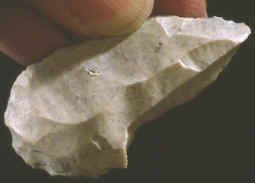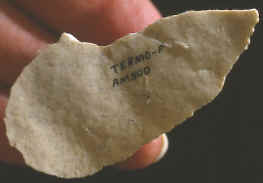|
SCRAPER /
BURIN
This combination Scraper-Burin was found on the Termo-Pialat site in southern France. This Upper Paleolithic Aurignacian site is located in the Couze Valley in the Dordogne region less than a mile west of the now famous Combe-Capelle site.
Burins were commonly used during Upper Paleolithic times. They are fairly rare in the archaeological record in North America. The chisel-like working edge is created by driving a flake off the thickness of an edge. These tools were used for engraving materials like bone, antler, ivory or wood. This blade tool was made from a very good quality white chert. It measures 2 3/16 inches (55mm) long and 1 1/16 inches (27mm) wide. The Aurignacian stone tool complex extends over much of Europe. It dates to the early part of the Upper Paleolithic between 34,000 and 29,000 years ago. Aurignacian sites are known to have existed during a period of very cold and dry climate. The Aurignacian type-site is Aurignac, which is located in southern France in the region of Haute Garonne. |
|
References: 1973,
"Le Malpas Rockshelter", by Anta Montet-White. |


